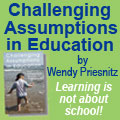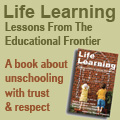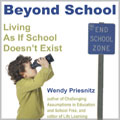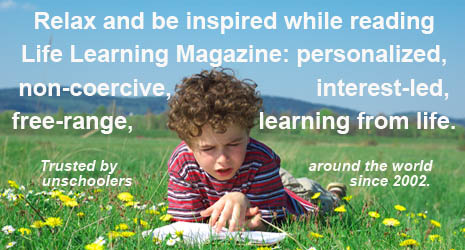|

Never Too Late To Learn to Read
By Jan Fortune-Wood
I was recently involved with a home educating family that was being pressured by the authorities because their two children, both under ten and both severely dyslexic, could not yet read. The truth is that there is no magic reading age. The truth is that here in the UK almost a third of children leave school after eleven years of state education and thousands of hours of structured literacy instruction, functionally illiterate. Yet the fact remains that literacy is an area where home educators, especially unschoolers and those nurturing their children’s autonomy and intrinsic motivation, can be made to feel extremely vulnerable and under pressure to conform.
Examining some of the responses to a large research project in the UK into home education, we came across a rather sad paragraph from one mother who said that she wanted to allow her child to develop at her own pace and learn things when she was intrinsically motivated to do so. But when she still wasn’t reading by the age of eight, the mother felt she was forced to admit defeat and realized that she would have to make her child read. The mother wanted to be one of those people who could claim that she had “painlessly and effortlessly” imparted reading, but said that she had to face reality and teach her child to read “before it was too late.”
There are two problems with this. Firstly, it makes the assumption that there is an age beyond which things will be “too late,” so forcing us to take pre-emptive action even if it’s not what the child wants. Secondly, it makes the assumption that if reading doesn’t happen by “magic” then we should panic and resort to coercion.
Different children learn to read at different ages and different individuals need different kinds of support and input. Some children do seem to learn to read by osmosis – they pick up the clues and take off without a formal lesson ever taking place, both at older and younger ages. Other children want and enjoy a more structured approach to literacy, but only when they chose and control it. The “painless and effortless” approach to literacy is wonderful for those for whom it works, and I’ve seen some great examples. But what matters most is responding to the individual.
For all kinds of cultural and historical reasons, reading has been the barometer of how we judge our children as successful learners and ourselves as adequate educators, which inevitably means that our feelings about the activity are complex and perhaps likely to cause anxiety.
One of the factors in this is the judgement of others – as alternative educators we live with the constant tension of knowing that we are under scrutiny and that mainstream theorists are just waiting to be able to point to our failures. This is a good argument for maintaining our children’s privacy, not in the sense of hiding away, but simply to put some distance between our children’s intrinsic learning and intrusive questions. Such questioners fail to understand that learning isn’t a matter of ticking off the right boxes at the prescribed ages; it soon gets old explaining to the umpteenth person something you know they are not going to believe anyway.
As parents, many of us take great pleasure in reading and when our children aren’t early readers we can worry that they are missing out on these magical imaginary worlds. Pleasure is an excellent motive for learning to read, but only when it is the child’s motive; we won’t enhance their pleasure by forcing the issue, far from it.) It’s also worth noting that in fact reading for pleasure is a falling statistic among children educated in schools.) The whole Harry Potter phenomenon revolves, in great part, around how amazing it is to find any book that children in numbers actually want to read.
This is a terrible indictment of mainstream education. There is no automatic or linear link between the skill of reading and the pleasure of reading and there is no corresponding need to fear that late reading might mean the pleasure won’t happen. Once the skill is an intrinsic desire rather than an externally imposed chore to be endured, then the pleasure will follow. In the meantime, there is a great deal of pleasure to be had from books that children can’t read themselves; being read to is a very pleasant experience both in terms of the story and the relationship with the reader.
-----------------
For more about unschooling and reading, click here to visit our index of free articles.
-----------------
The key to reading is making the association with an area of interest. At various stages, and for their own reasons, most children reach a stage where their pre-literate interests and pursuits become less compelling or all-consuming and the child is searching for new outlets. This can also work in the other direction, when reading and interests become inextricably linked. A child might have a new interest in fantasy-figure game playing or computer games, but find that his literacy doesn’t match his interests. With this new motivation, the resulting transformation in literacy can be very rapid. Sometimes it is reading in itself that becomes the new area of interest, perhaps with a child having an internal awareness, even if it is not fully articulated, that literacy will open up new areas of interest for her.
The obsession with literacy at set ages and stages is bolstered within conventional educational thinking by a network of pervasive myths about what are considered to be the essentials of learning, including the acquisition of what are commonly called “basic skills.” This belief that there is a homogenous body of knowledge which everyone needs to know also gives rise to a rigid stereotyping of what is deemed to be “age appropriate” learning and a widespread misconception that proper education is something that can be called “balanced.”
Autonomous educators do not buy into these misconceptions; essentials, age stereotyped learning, and balance are all concepts which pose a serious threat to children’s intrinsic motivation and their own innate curiosity and drive to learn.
In British schools, under the current literacy strategy, children in the first seven years of primary education spend at least 1,960 hours learning to read, whereas John Taylor Gatto has estimated that the combined key skills of literacy and numeracy can easily be achieved by a motivated and interested child in up to 100 hours. The anecdotal evidence of many home educators who follow an autonomous approach confirms that such a basic skill as literacy can be picked up even more quickly than this when the motivation to read is fully intrinsic. In short, children in school are wasting a minimum of 1,910 of those literacy hours.
Yet this horrendous waste of hours is of less concern than the damage this formal instruction does to children’s thinking processes and their ability to motivate and control their own learning. Children are losing opportunities for their own intrinsic learning and play. They might easily grow up never to take pleasure in a book again. Ironically, in an increasingly technical society, the age at which reading is necessary for participation in many of society’s activities is rising.
Children can use computers, play video games and access visually presented information, as well as enjoy all the traditional pleasures of childhood learning through play and art, long before they need to decode symbolic language. Home educating parents whose children learn by an autonomous route know that their children will acquire the skills they need to take advantage of their environment and pursue their own aspirations. We also know that however the “essentials” are defined, they will be acquired without resort to lesson plans, set hours or externally imposed motivation.
Autonomously educating parents are culturally peculiar in respecting our children’s intrinsic learning capability and in trusting that children will use this capability at the right time and in the right spheres for their best educational growth. We are also acutely aware that not to respect our children in such ways can have devastating consequences for the learning process. Autonomous education does not set out not to transmit a body of essentials which can be systematically worked through and ticked off the curriculum list. Instead, autonomous education sets out to support children in achieving what they wish to achieve and negotiating their own creative and individual place in the world according to their own intrinsic motivation.
To parent in this way takes a great deal of courage in the current educational climate. It takes a great measure of trust in our children specifically, in humanity’s intrinsic motivation to learn generally, and in our role as fully engaged parents and educators. The courage and the trust comes from living in an environment of life long learning and consent and from networking to get support for such a lifestyle. We may be in the minority, but I personally know that reading, and any of the other so called essentials, are acquired by children in a variety of ways and over a broad age spectrum without any of the stress of coercion and without any overall loss to the learning process or the love of books. Intrinsic motivation is never too late.
Jan Fortune-Wood lives and works in Wales, UK as a freelance writer, poet, publisher, parenting adviser, and humanist liturgist (developing ceremonies and rites of passage). She has written many articles for Life Learning Magazine, and is author of four books on home education, autonomous education, and non-coercive parenting: (Doing It Their Way; Without Boundaries; Bound To Be Free; and With Consent, all published by Educational Heretics Press). She unschooled her own four children.
Copyright © Life Media
Privacy Policy
  
  

|

